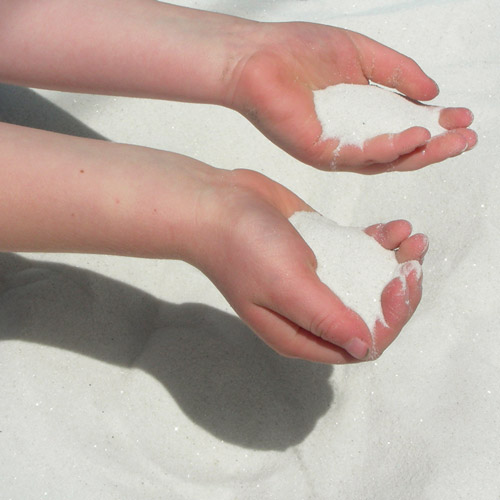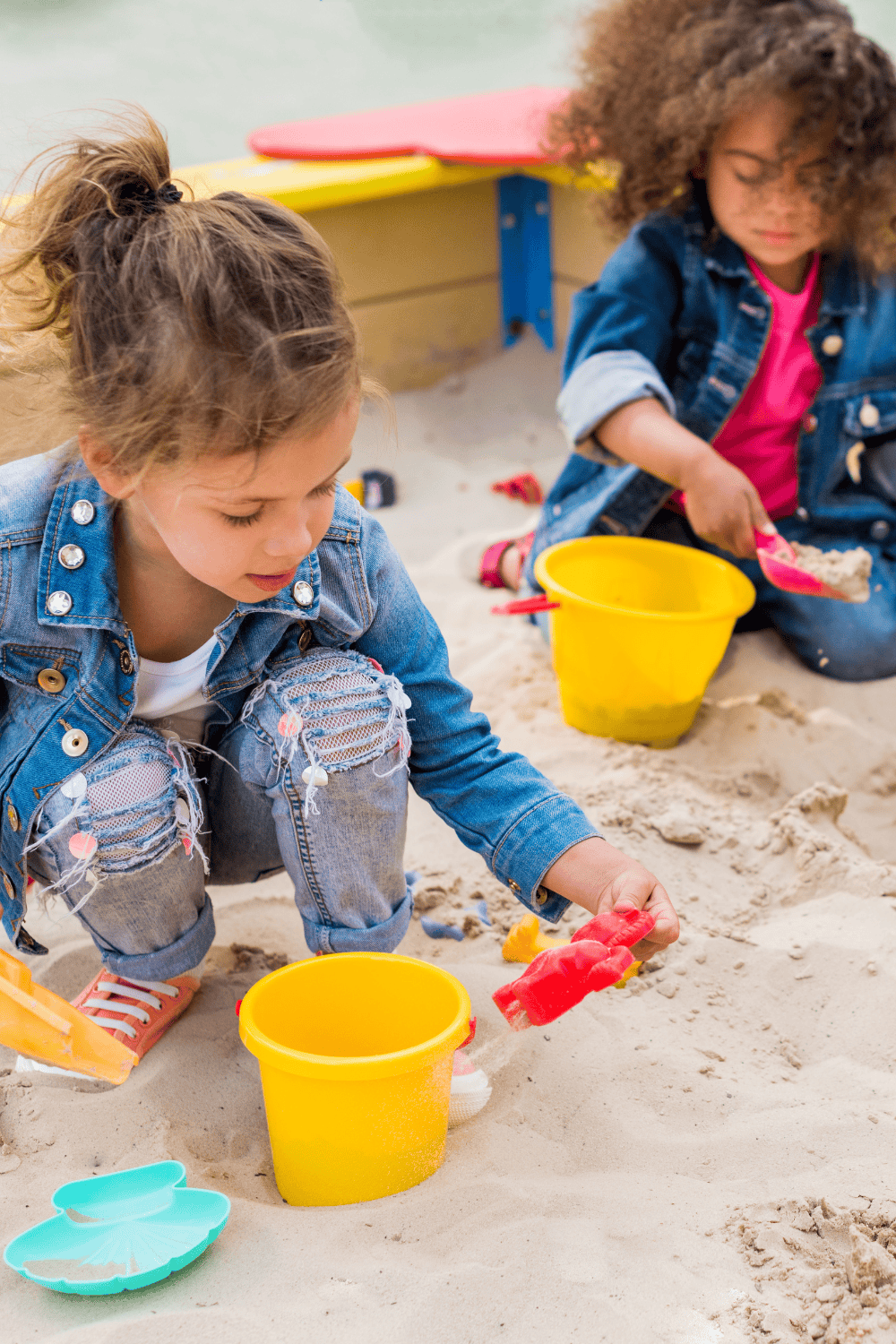Written by Denine W.
I remember that I was first introduced to kinetic sand when I was in kindergarten. I loved the feel of the sand, and I loved watching it move through my fingers. It reminded me of the sand in an hourglass.
The teacher always let us create whatever fun shapes we wanted during playtime. Kinetic sand as a kid’s toy provides a host of benefits, but is this type of malleable sand safe and non-toxic for your kids?
I’ve got everything you need to know about kinetic sand, and I even have a safe kinetic sand brand recommendation for you.
Table of Contents
- What Is Kinetic Sand?
- Is Kinetic Sand Toxic?
- Lack of Transparency in Kinetic Sand
- Safe Alternatives to Kinetic Sand
- Kinetic Sand FAQs
- What if my kid eats the sand?
- Is kinetic sand safe for pets?
- What is the difference between kinetic sand and regular sand?
- Final Thoughts on the Best Kinetic Sand That’s Safe
What Is Kinetic Sand?
Kinetic sand, also called kinetic sensory sand, is a moldable sand that sticks together (much like wet sea sand but without the wetness). It’s typically made of a combination of 98% ultra-fine grain sand and 2% polymer.
The polymer is a “magic” silicone oil compound, known as dimethicone or polydimethylsiloxane. Silicone oil is used in everyday household products and even diaper cream solutions.
It is a non-Newtonian fluid, meaning the kinetic sand stays fluid or loose when, for example, it’s left on a table, but it retains its shape when stress is applied, like when kids squeeze or mold the sand.
Kinetic sand is available in every color under the sun, including metallic and neon options.
As children have fun with kinetic sand, their senses are stimulated because they can build 3D objects like sandcastles, shapes, animals, and more. Kids can also use cookie cutters to create various shapes. After a relatively short period when left in its sculpted or shaped form, kinetic sand will go back to its loose shape.
Benefits of Kinetic Sand for Kids Play

There are various benefits of playing with kinetic sands:
- Kinetic sand is easy to clean since the sand only sticks to itself.
- It’s an ideal sensory toy in any weather.
- Promotes hand-eye coordination.
- Encourages creativity.
- Improves fine motor skills.
- Playing with kinetic sand is relaxing and fun.
Is Kinetic Sand Toxic?
If you have kids, you want to make sure that they are safe when they play with toys like kinetic sand. So… is kinetic sand safe?
The majority of kinetic sand is made from regular sand, and where this sand is sourced from can be the main cause for concern.
Regular sand that’s sourced from quarries isn’t safe because it contains crystalline silica, which is a carcinogen. There are also other types of play sands that contain tremolite, a form of asbestos (also a carcinogen).
(If you want to know more about the risks regular sand pose to kids and adults, check out my article on where to find non-toxic sandbox sand.)
Home
3 Best Brands for Non-Toxic Sandbox Sand in 2024
Discover the 3 safest, non-toxic play sand brands for your kids. Skip the worry about hidden chemicals lurking in your sandbox and focus on creative fun.
Lack of Transparency in Kinetic Sand
Ensuring you buy kinetic sand that’s safe for your kids means looking at the ingredients listed by the brand.
For example, one of the most well-known and widely use brands, Kinetic Sand, doesn’t reveal what goes into their kinetic sand formula. The company just says “We are unable to provide the ingredients of Kinetic Sand” and that they’ve performed toxicological risk assessments via third-party labs to verify that the ingredients are child-safe.
It’s not uncommon for companies to withhold their ingredient lists, claiming that they have to protect their “proprietary information,” but we believe consumers have the right to know what’s in the products they buy.
(Not to mention, companies often use this excuse to hide known toxins, as in the case of “fragrance.”
A company that actually wants to build trust won’t have any problem sharing what their ingredients are. So the fact that Kinetic Sand doesn’t share their kinetic sand ingredients is a red flag. While you can choose to trust that Kinetic Sand’s ingredients are safe, you don’t know for sure that there aren’t any carcinogens or other toxins in their product.
Safe Alternatives to Kinetic Sand

If you opt to be careful and not buy Kinetic Sand’s product for your little ones, then what can you buy that’s safe and similar to kinetic sand?
Safe Sand White Playsand
We recommend Safe Sand White Playsand as the best and safest kinetic sand alternative.
The White Playsand is naturally fine since it’s made from feldspathic sand. The product is free from lead, asbestos, and crystalline silica dust, making it non-toxic and safe for children to play with. The company shares the test results so you can verify the product is safe.
The biggest advantage of Safe Sand White Playsand is that you can use it for play in a sandbox or, when wet, it’s safe kinetic sand that holds its shape well.
It’s important to note that this playsand is not as moldable as true kinetic sand, especially when it’s dry. It’s going to be messier than true kinetic sand, so we recommend keeping the sand in a small box or tray (if playing with it indoors) or a sandbox (if playing with it outdoors).
DIY Kinetic Sand
Another option is to make your own kinetic sand. You’ll need:
- 2.5 cups non-toxic, fine play sand (like the Safe Sand White Playsand, beach sand, or river sand)
- 1.5 cups cornstarch
- 0.5 cups vegetable, mineral, or baby oil
In a container, mix the sand and cornstarch together. Then add the oil and mix until there are no dry or oily spots.
It’s that easy!
Kids
Eco-Friendly & Non-Toxic School Supplies for 2024
If you’d prefer to go with more natural materials when possible, here’s our guide to more sustainable & non-toxic school supplies for 2023!
Kinetic Sand FAQs
What if my kid eats the sand?
Kinetic sand is non-edible, but it is generally non-toxic (as long as the regular sand component is non-toxic). So if your kid eats the play sand, it won’t poison them.
However, kinetic sand is a choking hazard. If a child under the age of 3 tries to eat kinetic sand, they may choke as they try to swallow the fine sand.
If an older child eats kinetic sand in large quantities, they may need surgery because of the sand’s unique properties. When the sand makes its way to your kid’s stomach, the contractions of the bowels aren’t able to move the kinetic sand along to clear their digestive tract.
Rather, the sand reshapes all the time, getting stuck in the bowels. This causes constipation. Surgery is the only option to remove the sand.
If a small amount of colored kinetic sand is ingested and it passes through, expect that your children will have a bowel movement in the color of the sand.

Is kinetic sand safe for pets?
Kinetic sand is dangerous for pets like cats and dogs. It’s a choking hazard, and if a dog eats kinetic sand, it sits in the animal’s stomach. It may get stuck and become unable to move along the digestive system to be pooped out. As such, surgery will be required to remove the kinetic sand.
What is the difference between kinetic sand and regular sand?
Regular sand is obtained from quartz rock, and it is toxic because it contains carcinogens. If water is added to regular sand to make it wet sand, the sand can hold its shape to an extent. On the other hand, kinetic sand is made from a mixture of fine sand and silicone oil, ensuring the sand won’t dry out. Kinetic sand, like wet beach sand, is malleable, and when formed into objects, it keeps its shape for a while.
Final Thoughts on the Best Kinetic Sand That’s Safe
While most sources state that kinetic sand is safe and not toxic, you know the truth. It is all about where the fine sand is obtained from that makes it safe or unsafe for your children to play with.
When choosing kinetic sand for your kids’ fun time activities, look at the product’s ingredients and don’t just blindly trust a brand that says “it’s been independently tested.”






